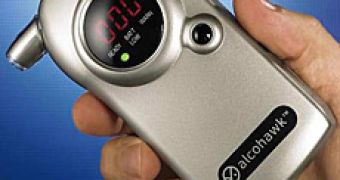I'm going to make this easy and simply say that a breathalyzer is a drunk driver's worst nightmare. You might have seen one on television, used on a person or even on you, but how does it work? A breathalyzer is a simple device used by law enforcements to determine whether or not a person driving a certain vehicle is intoxicated and if the alcohol concentration in the suspect's blood falls within legal limits.
The principle on which most breathalyzers work actually involves measuring the concentration of alcohol in the air exhaled by the suspect, from which the device extrapolates the concentration of alcohol in the bloodstream. Since alcohol is not immediately digested, it may remain in the bloodstream for up to several hours after it's been ingested. Part of the blood then passes in the lungs, where traces of alcohol will eventually be released along with the exhaled air and instantly detected by the breathalyzer.
The ratio of alcohol concentration in the exhaled air in relation to the concentration in the blood is about 2,100:1, meaning that 2,100 milliliters of exhaled air will contain an identical amount of alcohol as 1 milliliter of blood. It's worth mentioning that the standard upper limit above which a driver is considered drunk is 0.08, or 0.08 grams of alcohol per 100 milliliters of blood.
There are several types of breathalyzers currently used throughout the world, amongst which the Breathalyzer, Intoxilyzer and the Alcosensor, all of which rely on measuring the alcohol concentrations in the exhaled air.
The Breathalyzer, is a simple device consisting of a sampling system, a reaction chamber and a detector. Part of the air that the suspect blows through the sampling system is redirected to the reaction chamber containing several chemicals that have the role of retaining and reacting with any trace of alcohol in the air.
When alcohol reacts with the compounds in the reaction chamber, it changes their color according to the concentration of alcohol in the air. This change in color is then measured with the help of a photocell system and displayed on a scale.
The Intoxilyzer, makes use of the optical properties of alcohol in the infrared spectrum. As air is being blown through a sampling chamber, an infrared beam is projected through the mass of air. The intensity of the beam is measured by a photocell for variations, after which it relays the obtained values to a microprocessor, which then calculates the concentration of alcohol in the blood.
Another type of widely used breathalyzer is the Alcosensor, which relies on a fuel-cell made out of two platinum electrodes separated by acid-electrolyte porous material. When air containing concentrations of alcohol flows from one side to the other, acetic acid is being produced along with positive ions and electrons. The first electrode collects the electrons, while the positive ions move to the other side of the cell where they combine with oxygen.
The electrical current established between the two electrodes represents an accurate test in revealing the concentration of alcohol in the exhaled air.

 14 DAY TRIAL //
14 DAY TRIAL //